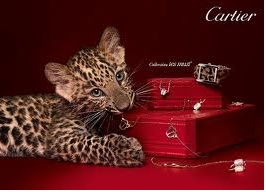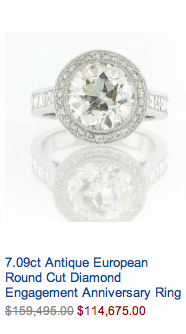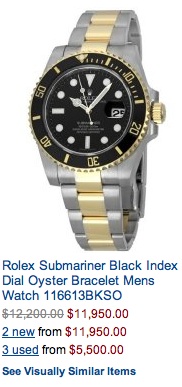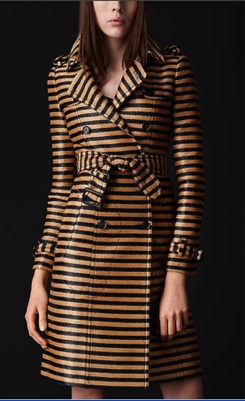Articles and News
EXCLUSIVE INTERVIEW: BRITA TURNER OF AMAZON.COM, ON LUXURY, JEWELERS, AND SUCCESS IN A DIGITAL WORLD February 22, 2012 (0 comments)

Seattle, WA—What’s the secret formula that built Amazon.com from discount bookseller into digital behemoth? Today it’s possible to furnish one’s house, whip up a fine risotto with rare truffles from Italy, and buy a Rolex watch or a seven-carat diamond ring, all on Amazon.com. And yes, you can still buy a book. Though today, you’re perhaps more apt to buy a Kindle, Amazon’s own homegrown brand that almost singlehandedly launched the e-reader category.
Brita Turner, the senior product manager for jewelry and watches for Amazon.com Marketplace, gave an exclusive interview to The Centurion editor Hedda Schupak about what luxury companies, especially jewelers, need to do to succeed in translating their brand into the digital space.
Turner has an unusual background: she earned her MBA (from University of North Carolina at Chapel Hill) specifically with a focus on international luxury brand management, studying abroad at the Essec MBA program in Paris, France. Turner also holds an undergraduate degree in finance from Lehigh University.
Hedda Schupak, The Centurion: When you studied luxury as an academic subject, what were the key points you learned?
Brita Turner, Amazon.com Marketplace: Some of the major trends within the luxury industry are to scale back on licensing, open more retail stores to showcase and convey a desired brand experience, launch new marketing campaigns such as co-branding and digital marketing, and expand the customer touch points in order to create a lifestyle centered around the brand. The major theme of these trends is to ensure that the brand itself has greater control over the brand image, shopping experience and customer interaction.
The combination of craftsmanship, heritage, quality, uniqueness, and creative audacity are components that have created and generated continued success of luxury brands. A luxury brand is born through exclusivity and the marketing of each of these components tied to creating a strong sense of emotion or passion. The sense of emotion is high because often the item is dreamt about and finally purchased after an individual earns the money to afford it. Then he or she is emotionally tied to the item and building a relationship with the brand for the long term.
For example, Cartier, originally established as a jeweler to European royalty, has grown to be one of the most prominent luxury jewelry brands. The brand is tied directly to quality, the best diamonds and materials in the world, the authenticity and originality of craftsmanship, and the leopard. One of the first jewelry creations for the brand in 1949, it now is the trademark used in every advertisement. Teenagers grow a sense of familiarity with the brand through magazines and publications, maybe their mother owns a piece, then they slowly start to acquire a passion for the brand, maybe first through purchasing the love bracelet, then an engagement ring, and by retirement another original piece. But, each piece is unique, rare, and valuable.

Whether it's represented in gold and enamel on a bracelet or chewing on the box, the leopard is iconic of Cartier.
The Centurion: How did those points compare to reality once you got into the work world? Was the academic view close to reality?
Turner: I think the academic view was very accurate picture of reality, as we took specific examples of companies and brands to study. But, the challenging part is the actual execution of the ideal image you want to create, and the amount of work and time required to fully implement these ideas. It is easy to sit and strategize what will create an ideal digital experience for a luxury brand or reflect on how specific brands need to update their image to adopt to changes in generations, but building the tactical plan for execution, hiring the staff, and then watching the adoption and customer response—which may end up not as planned—is challenging. It’s important to constantly innovate, employ the customer to provide continual feedback on how they are changing, and reflect this back into your strategy. I personally get caught up in my daily tasks of marketing, sales, and execution. It can be hard to pull back frequently enough to notice how the world around me is changing, and how to stay ahead of the curve, especially in this digital era when changes happen so quickly.
Also, now that I am working for an Internet company, it has really hit me how important it is for retailers to have some sort of digital presence. In class, we discussed the reasons as to why having an online footprint is important, but the more I interact digitally, the more opportunities I uncover that could be used to build incremental brand awareness and sales. I had no idea how many people research products online, purchase online, and interact online, or the vast amount of tools that can be leveraged online. Retailers should be utilizing these tools much more to their advantage, because if they aren’t talking to their customers online, somebody else is.
Additionally, I didn’t realize how rooted the digital space is in the lives of the younger generations. A majority of their day is spent online; between mobile devices, tablets, and computers, they are constantly connected, communicating, researching, and buying. For every $1 purchased online, $6 are researched online and purchased offline, and the online space is projected to influence more than half of total U.S. retail sales by 2014. (Editor’s note: Recent figures from the U.S. Dept. of Commerce show five cents of every retail dollar is spent online.)


Amazon.com isn't just for books anymore. A seven-carat diamond ring and a Rolex watch were among the items offered at press time.
The Centurion: Has anything changed between then and now?
Turner: I actually see a lot more co-branding occurring in marketing across luxury brands within the United States that did not exist as much when I was studying luxury goods. We do see jewelry placement on celebrities for key red carpet events, but rarely collaboration between a fine jeweler and another brand within the US.
I also see social media strategies maturing and gaining weight in the traditional marketing strategy and structure of companies. Social media is now allocated a separate line item within the budget as well as resources in order to build and implement a comprehensive strategy. The importance social media plays has definitely grown over the last year.
The Centurion: What are some key differences and similarities in luxury consumers from different regions or cultures?
Turner: It is interesting to look at the breakdown of luxury sales by region and by nationality. Looking at luxury good sales by region, Europe is the largest market (approx. 42%). Asia, excluding Japan, and the United States are tied at around 20-22%, and Japan claims around 16%. Looking at luxury sales by [regional] nationality, Europe accounts for an estimated 30% of total sales, while Japan accounts for an estimated 22% and Asia excluding Japan estimated at 28%, leaving the United States with 20%. The Asian nationality is by far the largest purchaser of luxury goods. The largest segments of luxury goods sold by category are ready-to-wear apparel (26% of sales), and leather & accessories (17%). Jewelry is one of the smallest categories sold globally, accounting for an estimated 5% of total luxury good sales. One reason for the success of leather and accessories in the Asian market is elimination of sizing as a factor: most items are one size fits all.
The Centurion: Do you see differences in luxury perspectives between different generations? If so, what are they and how does a retailer respond?
Turner: The key difference between generations and their perspective on luxury goods is the usage of technology. We are inundated with clutter all day long, so the ability to break through the competitive marketing and continue to create an emotional experience as a lifestyle brand is what will ensure long-term success. Targeting the individuals that want to listen to you, and telling them something they want to hear is not only important with the younger generations but also possible through recent technological advances.
Traditionally a brand could advertise through [magazines like] Vogue, the customer would recognize the brand, they would go to the store, and it was simple. Today, there is much more competition for customer’s attention due to digital advancements, including social and online media, digital publications, and smart phones. A brand has to be savvy on how to reach its customer, and target its message accordingly.
The Centurion: If you were going to teach a class of independent luxury jewelers how to thrive in a changing marketplace, what would be the three most important things you’d address?
Turner: Not to be afraid of technology and the worldwide web. There is a misconception that a luxury experience cannot be created for jewelry online. Stick to what you know. Emphasizing heritage, quality, and craftsmanship is critical in the fine jewelry industry. Campaigns should include information on when the company was founded, pride in offering the best quality materials and unique and creative styles.
But, the campaigns should be targeted with relevant messaging to different target markets in a way that market can relate to best. Today, this means building a digital strategy incorporating e-commerce, email marketing, search engine marketing, and social media in addition to traditional marketing techniques. Selling jewelry online can be a bit trickier as the customer can’t try the item on, but this can be overcome by offering multiple high quality images combined with video.
The Centurion: What do you think the jewelry industry does well on the digital front?
Turner: I think many luxury jewelry brands have worked hard to create a seamless experience as far as the portrayal of their brand image is concerned online. For example, Cartier, Gurhan, and Tiffany have developed websites full of images and videos, company history, music and beautiful graphics. But, there is still a lot of opportunity to improve the shopping experience and site navigation.
The Centurion: Where do you think the jewelry industry most needs to improve on the digital front?
Turner: There is such a great opportunity right now in the digital space for fine jewelry. Luxury retailers seem very timid and intimidated when it comes to the digital front. There are four areas in which I believe the jewelry industry needs to improve the most:
- Communication. No longer is communication a one-way street. Customers enjoy engaging with the brands they are interested in, asking questions, learning beyond what was originally shared, and conversing on a regular basis about the products they love. Jewelers need to be open to both hearing and sharing the feedback they receive, and communicate with customers more openly about the quality and heritage of their brand.
- Launching and modernizing the look and feel of digital campaigns. Looking within the luxury space I admire the digital campaigns that Burberry has launched. Take an old stodgy British trench coat traditionally used throughout time, built a sexy campaign called the “Art of the Trench” allowing customers to submit personal photos wearing the product online, add in newly launched music and a print campaign by Emma Watson (updated seasonally with a new actress), and a new image of a trench coat is formed. Jewelers need to keep the core of what is important and iconic for jewelry, but modernize the image customers have of jewelers and the purchasing process. Proactively identifying new ways to share information with customers and modernizing the message portrayed to customers is crucial.
- Creating a lifestyle brand engaged throughout the customer’s entire purchase cycle. “A jeweler is a relationship for life,” one Amazon.com jewelry seller once said to me. When a couple purchases a piece of jewelry, for example an engagement ring, that is the jeweler the couple will turn to for wedding bands, maternity gifts, bridesmaids’ jewelry, etc. It is important that the company establish a relationship through digital channels with its customers throughout their entire purchase cycle. This includes branching out from the traditional single touch-point of a sale through their website, but continuing to engage the customer both before and after the purchase.
- Willingness to view the online space as a legitimate sales channel. Embracing the Internet as not only a platform to market, but also a platform to sell product is critical. Customers are becoming more digitally savvy, and online shoppers are proven to have higher net incomes then offline shoppers. Reaching out to the younger generations that are currently aspirational shoppers is important, because for jewelers this is a missed opportunity in the market right now.


The Art of the Trench: Burberry (right) has definitely changed the image of the classic rumpled raincoat.
The Centurion: Realizing that anyone who sells jewelry is competition, how can jewelers compete with a behemoth like Amazon?
Turner: One fundamental way is for jewelers to leverage the third party platform or marketplace on Amazon to sell their own products and access current Amazon customers. We offer a unique segmented shopping experience and exclusive targeted marketing for luxury brands. I guess I don’t really see the difference between Amazon.com and Neiman Marcus or Nordstrom. There are many large players within the retail industry. I think its more about being open minded about adapting to where your customers are shopping and purchasing products, and being able to sell through multiple channels.

The digital era has done the luxury segment a huge favor: it has made the products accessible. At one time, customers had to travel to the one or two stores in the country in order to purchase an item. When I was growing up I knew Tiffany & Co. through movies I watched, but there were no stores in North Carolina, so I had limited accessibility to even learn about this brand until I moved to the New York area in 2000. The digital era has completely changed this. Customers in remote areas can now learn about the newest Balenciaga bag or Jimmy Choo shoe through their website or mobile application, and they can purchase it today. Amazon is one of the contributing factors to this trend. The fact that customers located all around the world can log on to Amazon and purchase a product they may have just read about in Cosmopolitan is unbelievable. I see Amazon more as a platform for brands of all sorts to sell and market their products to millions of customers. Amazon is an epicenter of research, and individuals looking for jewelry visit our site all the time to learn about brands and products, and either purchase it through us, a competitor, or a retail store. The more channels a fine jewelry brand can enter into, the better the overall awareness of their brand and exposure of their products.







